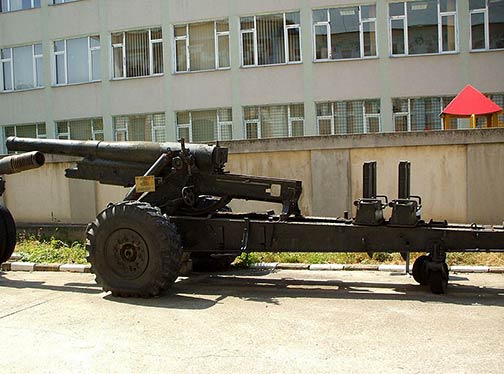Škoda 149 mm K4 howitzer, also known as 15 cm hruba houfnice vzor 37 in Czechoslovakia and as the 15 cm schwere Feldhaubitze 37(t) in German service.
Greece, Czechoslovak-made 15 cm schwere Feldhaubitze 37(t) / sFH 37(t) (also known as Škoda 149 mm K-series)
Limber for 15 cm heavy field howitzer 37 (t).
By the early 1930s the Skoda works at Pilsen in Czechoslovakia were in a position to design, develop and produce entirely new artillery pieces that owed nothing to the old World War I weapons that had hitherto been the company’s main output. By 1933 they had produced, among other things, an entirely new 149-mm (5.87-in) range of howitzers known as the ‘K’ series. The first of these, the Kl, was produced in 1933 and the entire output of these vz 33 weapons went for export to Turkey, Romania and Yugoslavia. The Kl was a thoroughly modern piece with a heavy split trail, and was designed for either horse or motorized traction. For the latter the piece could be towed as one load, but for the former the barrel could be removed for towing as a separate load.
Despite the success of the Kl, the Czech army decided that the weapon did not meet its exact requirements and funded further development to the stage where a K4 model met the specification. The K4 had much in common with the earlier K1, but had a shorter barrel and (as the Czech army was making considerable strides towards full mechanization) the need for removing the barrel for separate horse traction was no longer required, The K4 also used pneumatic wheels (the Kl had solid rubber-rimmed steel wheels) and some other modifications to suit it for the mechanized tractor towing role.
With these changes the Czech army decided to adopt the K4 as its standard heavy field howitzer to replace the large range of elderly weapons remaining from World War I. The K4 was given the army designation 15-cm hrubâ houfnice vz 37, vz 37 (vz for vzor, or model) denoting the equipment’s year of acceptance for service, Skoda drew up production plans, but as always this took time and in the interim the Germans occupied the Czech Sudetenland. Plans for production became even more frantic, but with the Sudetenland line of defences in German hands Czechoslovakia was wide open to further German aggression and in 1939 they duly marched in to take over the rest of the country.
The Germans also secured the Skoda works at Pilsen, finding on the production lines the first of the full production vz 37 weapons. By that time only a few models had been produced, and these the German army tested on ranges back in the Reich, discovering that the vz 37 was a sound and serviceable howitzer with a good range of 15100m (16,515 yards) and firing a very useful 42-kg (92.6-lb) projectile. The Germans decided to keep the vz 37 in production at Pilsen for their own requirements, and thus the vz 37 became the German army’s 15-cm schwere Feldhaubitze 37(t), or 15-cm heavy field howitzer Model 1937 (Czech), the (t) denoting tschechisch, or Czech. With the German army the sFH 37(t) became a standard weapon of many divisions, forming part of the divisional artillery equipment and even being used by some corps batteries. It was used during the French campaign of May and June 1940, and later in the invasion of the Soviet Union during 1941. Some were still in service in the Soviet Union as late as 1944, but by then many had been passed to the various Balkan forces under German control and operating within what is now Yugoslavia; the Slovak army was one such recipient.
Specification
SFH 37(t)
Calibre: 149.1 mm (5.87 in)
Length of piece: 3.60 m (11 ft 9.7 in)
Weight: travelling 5730 kg (12,632 lb) and in action 5200 kg ( 11,464 lb)
Elevation:-5° to+70°
Traverse: 45°
Muzzle velocity: 580 m (1,903 ft) per second
Maximum range: 15100 m (16,515 yards)
Shell weight: 42 kg (92.6 lb)
